The What’s Market Series is an ongoing project that takes a closer look at contract terms and provisions in vendor, customer and negotiated contracts. We will be using data gathered by TermScout, which uses AI assisted by contract professionals to accurately review and rate contracts, in order to drive our findings.
In this article we look at one of the most crucial aspects of contracts: term and termination. More specifically, we delve into what type of termination rights exist for customers, and how common they exist within contracts.
Term & Termination
Contractual relationships can break down for a multitude of reasons, and broad termination rights allow a party to more easily exit the relationship while minimizing its liabilities. The termination clause of a contract sets the parameters for each party’s performance. If these parameters are breached (i.e., a party terminates the contract early), there may be consequences involved, depending on the termination rights that have been granted. There are two general types of termination rights: termination for cause and termination for convenience.
Termination for cause specifically deals with a breach of contract by either party, which would allow the non-breaching party to terminate the contract. The scope of what is included in a party’s termination for cause right is determined by the contract itself, which may limit “for cause” to material breaches of the contract, or the contract may have a broad definition of “for cause” that includes any reason that a party reasonably deems to be a breach. Parties spend considerable time negotiating the scope of a termination for cause right, as each party wants broad termination rights for itself, and limited termination rights for the counterparty.
The second standard termination right is termination for convenience, which allows a party to end a contract at its discretion. A termination for convenience right may come with certain conditions, such as a required amount of notice. The ability to terminate for convenience without notice is the broadest termination right available, as it allows a party to escape its obligations without “cause.” Because of this, it is rare, in comparison to for “cause” termination, for parties to have termination for convenience rights. However, parties with strong bargaining power may have the right to terminate for convenience.
The final aspect of customer termination we’ll be looking at today is whether a contract has an auto-renewal clause. Auto-renewal clauses will automatically extend the term of a contract beyond the initial agreed term for a defined interval of time. Customers may seek the right to opt out of an auto-renewal clause within a certain amount of time to prevent a contract from renewing, and thereby preventing further financial obligations (note, however, that if customers have a termination for convenience right, this issue is moot). Furthermore, depending on the circumstances of the contract, customers may accept auto-renewal clauses as a way to keep the contractual process smooth. Either way, auto-renewal is another important facet of termination rights.
Vendor v. Customer v. Negotiated Contracts
While it is in both parties’ interest to have an exit plan should things go south, the data gathered by TermScout below focuses on the customer’s rights to terminate, whether the contract auto-renews, and whether the customer can opt out. TermScout has reviewed 591 vendor Forms, 101 customer Forms and 94 negotiated contracts in order to provide a clearer picture of how often options for termination are offered and if so, what they are.
What Vendors Offer (591)
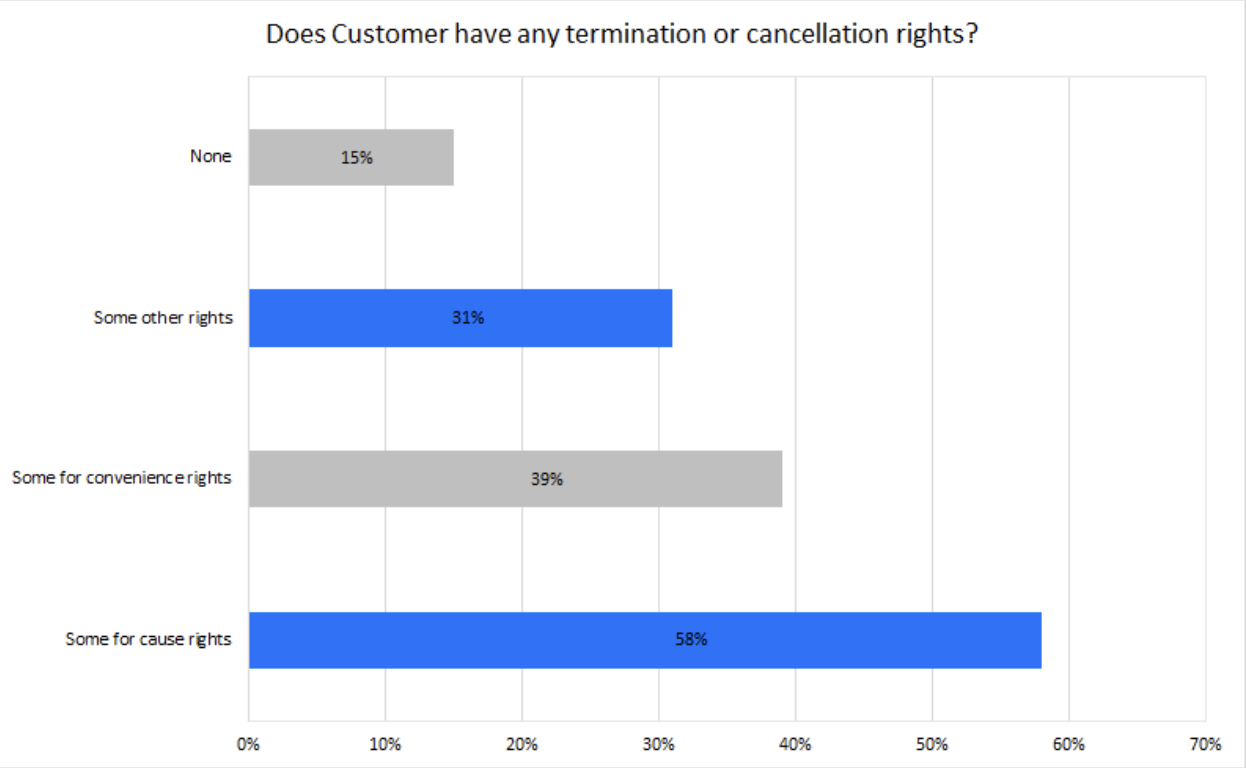
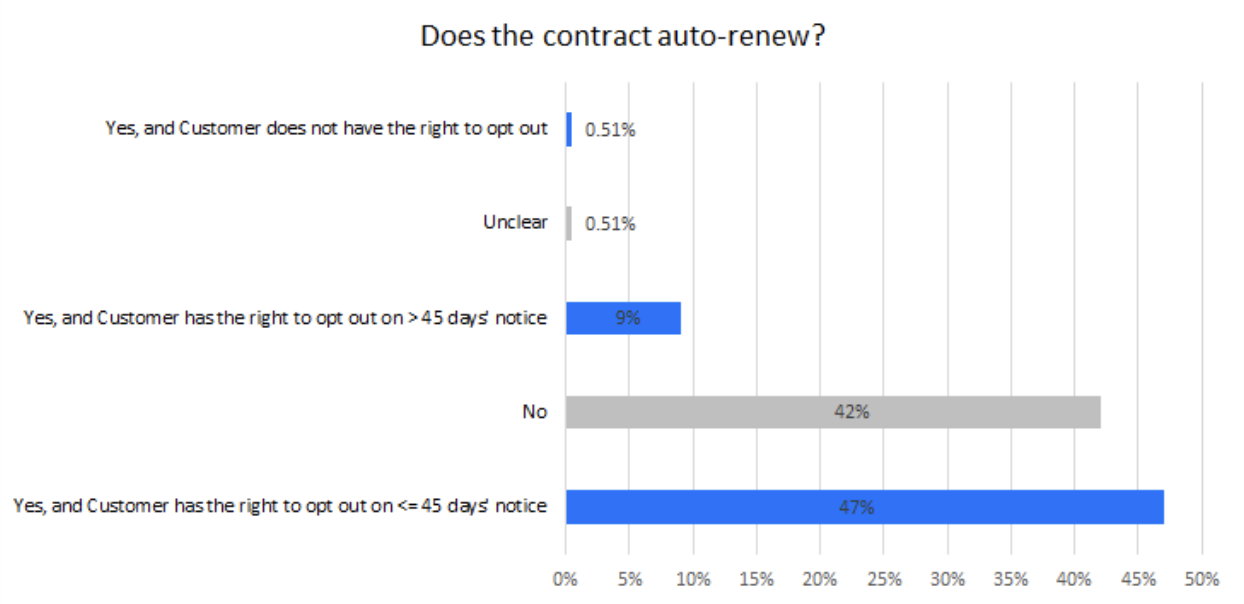
Predominantly, vendors offer termination for cause, with a smaller amount offering termination for convenience. Overall, it is clear that most vendors understand that customers want the option to terminate early, with only 15% not offering any cancellation rights. Additionally, when we take a look at whether the contract auto-renews, we see that while the majority of contracts do auto-renew, 42% do not. Only in a very minute number of cases (15% and .51%, respectively) does the customer not have any termination or opt-out rights. This information supports the idea that while vendors may be hesitant to offer early termination rights, they understand the importance of termination to customers and are willing to concede on this position.
What Customers Offer (101)
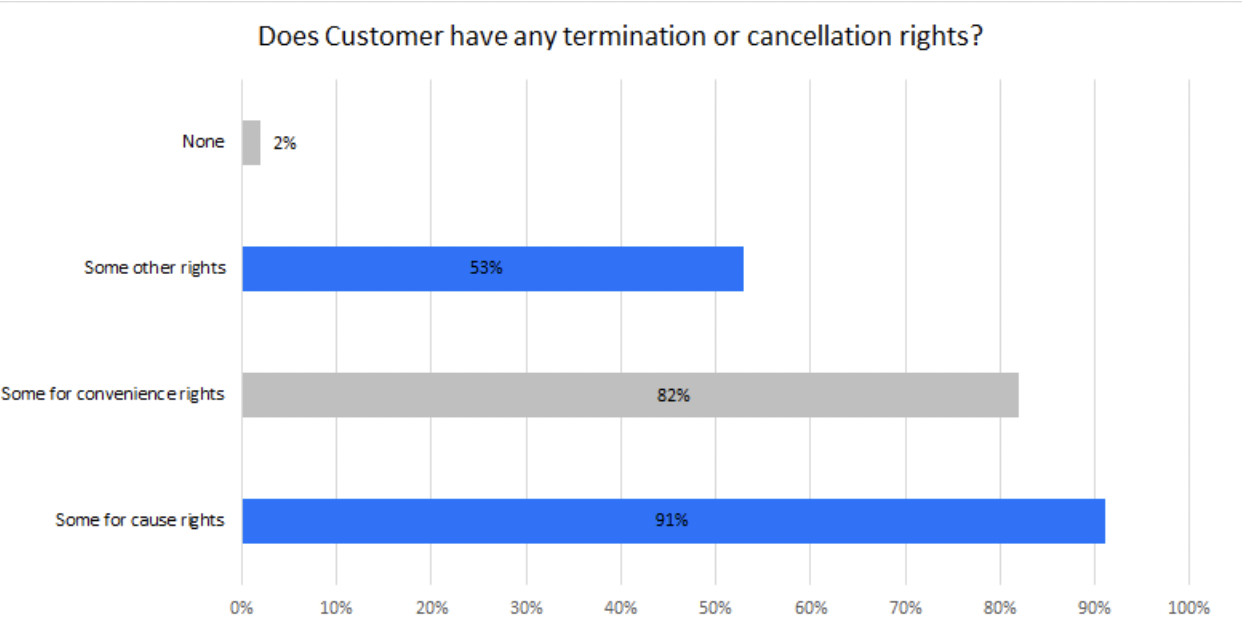

In a stark contrast from vendor forms, we see that in customer forms, the customer’s dominant starting position is to have broad termination for cause and convenience rights, with a whopping 91% containing termination for cause rights and another 82% also containing termination for convenience rights. Customers want to maintain maximum flexibility in the event the customer needs to escape its liabilities at any time, or if the vendor breaches the agreement. This pattern continues when looking at auto-renewal, as we once again see the overwhelming popularity of customer forms that do not contain an auto-renewal provision, and zero customer forms that have both an auto-renewal provision, and don’t allow the customer to opt-out. Interestingly, we see this pattern not only in the customer forms but negotiated contracts as well.
Negotiated Contracts (94)
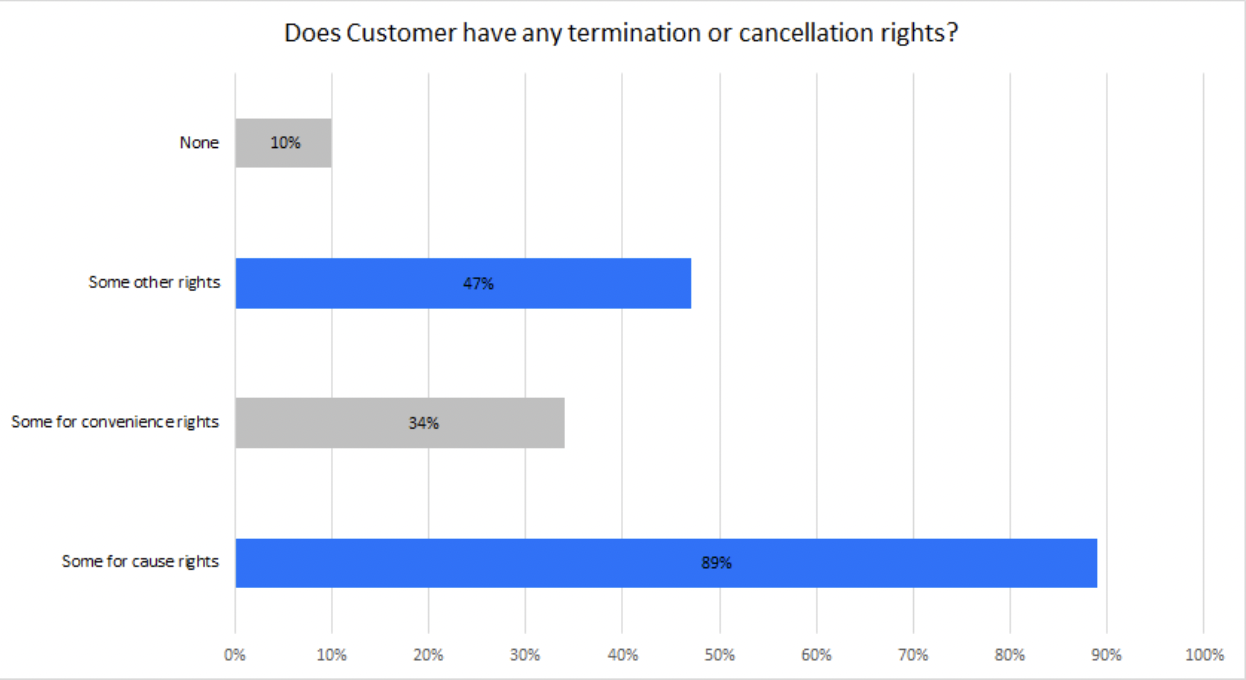
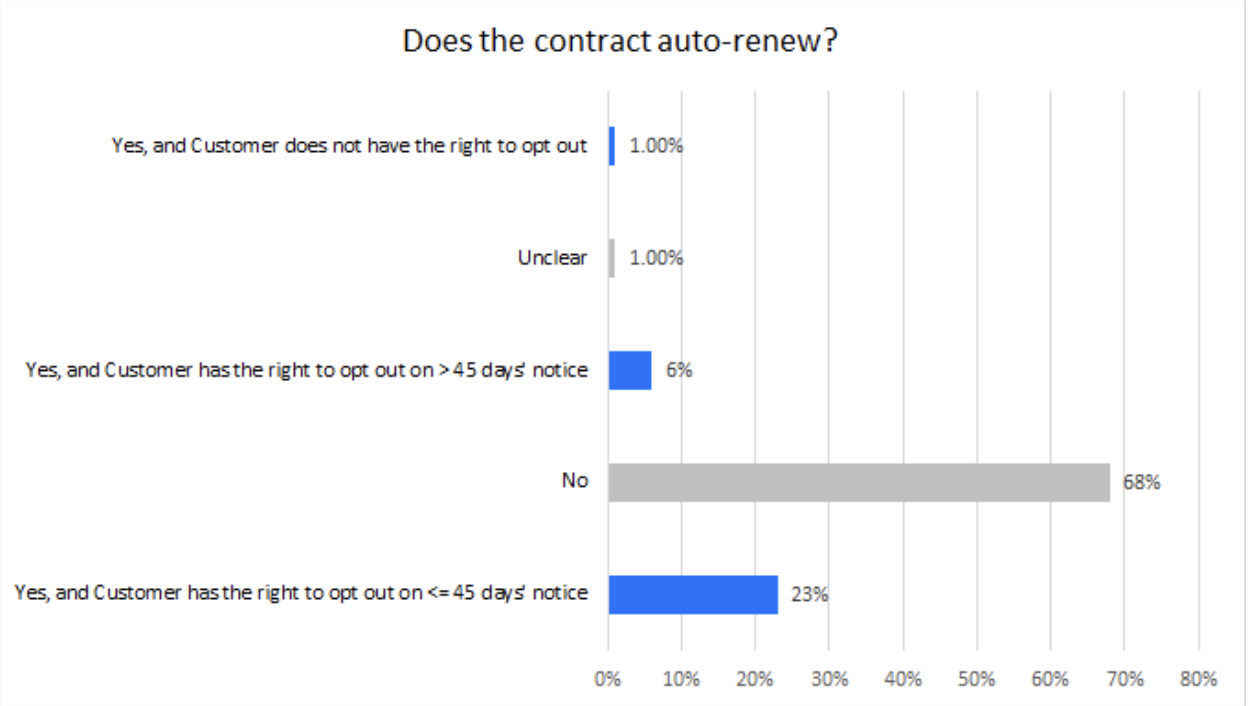
Lastly, as we look at negotiated contracts, we can see the impact that negotiation has for customers as compared to vendor forms. 89% of negotiated contracts contain some termination for cause rights, while 34% include termination for convenience rights. In all aspects, except convenience rights, termination clauses appear to lean in favor of the customer. While the customer has termination for convenience rights less often in negotiated contracts, it is likely that customers make a concession in exchange for other priorities. Similarly, when we look at auto-renewal, the customer has been able to negotiate out of an auto-renewal clause in 68% of contracts. While a small percentage of contracts still do contain an auto-renewal clause, it is less than a third. This truly highlights the power of negotiation and the difference it can have for the customer.
Representative Provisions
Examples of Companies where Customer has some cause rights
- Automox: 11.3, Master Services Agreement
- Cision: 4.2, Master Services Agreement
- Jira Service Desk: 17.2, Terms of Service
- TalentLMS: 9(2), Terms of Service
Examples of Companies where Customer has some convenience rights
- Google Analytics: 14, Terms of Service
- Jira Service Desk: 17.3, Terms of Service
- TalentLMS: 9(3), Terms of Service
- UpperCampus: Term and Termination(4), Terms of Use
Examples of Companies where Customer has some other rights
- Cvent: 12.3, Terms of Use
- LinkedIn: 5.2, LinkedIn Subscription Agreement
- New Relic: 9.2, Terms of Service
- Scalefusion: 8.2, Terms of Service
Examples of Companies where Customer has no termination rights
- Box: 20, Terms of Service
- FastSpring: 1.4, Terms and Conditions
- Nutshell: Term and Termination, EULA
- PracticePanther: 16, PracticePanther User Agreement
Examples of Companies where Contract does not auto-renew
- AG Grid: 14.1, Terms and Conditions
- Aclima: 7.1, EULA
- FullContact: 3(a), Service Agreement
- Mural: 9.1, Service Agreement
Examples of Companies where Contract does auto-renew and customer does not have the right to opt out
- 1Password: 9.1 and 9.2, Subscription Terms for Business Customers
- SolarWinds: 5.1, Software Services Agreement
Examples of Companies where Contract does auto-renew and customer does have the right to opt out <=45 days’ notice
- airSlate: 21, Terms of Service
- Brainshark:11.1, Terms and Conditions
- Outreach: Term and Termination; Suspension, Terms of Service
- Podium: 8.1, Terms of Service
Examples of Companies where Contract does auto-renew and customer does have the right to opt out >45 days’ notice
- Docebo: 11.1, Master Software as a Service Agreement
- Kronos Workforce: 2.1, Terms and Conditions
- Seventh Sense: TERM AND TERMINATION (b), Terms of Service
- Xvoucher: 8, Services Provider Agreement
Final Thoughts
Without a doubt, the clauses surrounding term and termination within a contract are critical. As we’ve discussed, vendors who commit time and resources to performance of the contract want to ensure that customers cannot escape the contract early without liability. Customers, on the other hand, are keen on having as many routes of escape as possible, preferring to not be locked into a deal if the deal no longer becomes practical to continue, or the vendor fails to meet its obligations. Through negotiation, we see that vendors recognize the importance of this freedom and are willing to adjust their stance.
As for auto-renewals, both parties have a vested interest. Vendors may prefer to lock in customers into auto-renewals; customers may prefer to keep maximum flexibility. However, auto-renewal may be preferable for some customers who want to lock in the terms of a contract long-term, provided that the customer still maintains the right to terminate for convenience, albeit with reasonable notice. In negotiation, it appears that the customer tends to fight harder, often getting their preference. As such, customers who wish to change the terms of their contracts’ termination or auto-renewal clauses should negotiate, while vendors may wish to give a little here, in order to secure a win elsewhere.
The What’s Market Series is published regularly, so keep an eye out for the next article, coming soon!
Share this
You May Also Like
These Related Stories

Vendor Indemnification Obligations: What’s Market in IT, SaaS, and PaaS Contracts

What’s Market? Protection of Confidential Information

.png?width=130&height=53&name=Vector%20(21).png)